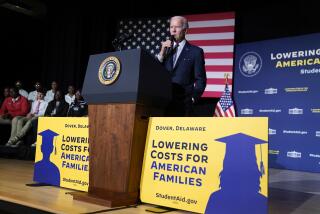Federal student loans are investments — not handouts
Dear Liz: I am increasingly annoyed by the entitlement attitude of today’s students. Why should the taxpayers (me) pay to educate somebody else’s children? I remember when there was no such thing as a student loan. If I wanted to go to college and didn’t have the money for tuition, I delayed starting college until I had worked for a year and saved up the money. Many of my friends did this, as did I. Now these kids stand around with their hands out looking for somebody to bring them their education on a silver platter. I wish you would say something about this in your column.
Answer: Let’s start with the obvious, which is that an education costs a heck of a lot more than it did when you were in college.
The College Board reports that a student attending an in-state, four-year public university needs to budget an average of $22,261 to pay for the 2012-13 year. Which means the total cost to get an undergraduate degree would be almost $90,000, assuming he or she can get all the required courses in four years (something that’s increasingly difficult because of state budget cuts in education).
Not to put too fine a point on it, but there aren’t many jobs these days that would enable someone (particularly someone without a college degree) to save the full cost of a college education in a single year. Even someone who started out with two years of community college would need to budget about $8,000 for each of those years, according to the College Board, and the total cost of a four-year degree would still be around $60,000. Some people would pay less if they got a lot of financial aid or lived at home, but any way you cut it, the tab is much, much higher than it has been in decades past.
Something else has changed since you were a student, and that’s the importance of having a college education if you want to have a decent financial life and remain in the middle class. In your day, people without college educations — even those without high school diplomas — could find well-paying jobs. Those jobs have increasingly been phased out by technology or they’ve gone overseas. The manufacturing and technical jobs that remain often require at least some post-secondary education. Having a college degree is what having a high school diploma used to be — an essential entry-level credential in many fields.
Our nation and our economy need educated workers if we’re to be competitive in a global economy. It also would help to have an expanding pool of well-paid workers to pay taxes toward things like roads, defense, police and fire protection and Social Security, from which you presumably benefit.
This is why governments promote post-secondary education with a relatively small amount of grants for the needy, and a relatively large amount of loans for everyone else. The first federal student loans were part of the National Defense Education Act of 1958; today, most students borrow at least some portion of their education costs.
You see, most kids (and their parents) aren’t standing around waiting for a handout. Most financial aid these days comes in the form of loans, which have to be paid back. These loans aren’t necessarily cheap — the rate on a Stafford student loan is 6.8%, while graduate and parent PLUS loans have 7.9% rates (plus a 4% origination fee that’s deducted from each disbursement).
If students or their parents default, the government can garnish their wages, seize their tax refunds, take a chunk of their Social Security checks and trash their credit. There is no statute of limitations on federal student loans and only rare relief in Bankruptcy Court, so borrowers can be pursued to their graves for what they owe.
Yes, many families overspend on education and overdose on student loans. The majority, however, graduate with a reasonable amount of debt (about $26,000 on average) that can be repaid from their now-higher earnings. Student loans aren’t a handout — they’re an investment in both the graduate and our economy.
How are Social Security benefits computed?
Dear Liz: I have been told over the years that your Social Security monthly benefit amount is computed using years closest to retirement. I have now been told benefits are calculated from your highest earning year in your working life. Which is true? I am 61 and unable to work more than part time for physical reasons, so now my income has gone down while I’m still contributing to Social Security from my earnings. Are my lower yearly earnings for the next couple of years going to lower my overall benefit when I do start drawing my benefit?
Answer: Your Social Security benefit is not based on either your earnings close to retirement or your highest-earning year. Your checks will be based on your 35 highest-earning years. That long period helps keep you from being too badly penalized if your earnings drop toward the end of your working career. You can find out more at https://www.ssa.gov/pubs/10070.html. You can estimate your future benefits with this calculator: https://www.ssa.gov/estimator.
Questions may be sent to 3940 Laurel Canyon, No. 238, Studio City, CA 91604 or by using the “Contact” form at asklizweston.com. Distributed by No More Red Inc.
More to Read
Inside the business of entertainment
The Wide Shot brings you news, analysis and insights on everything from streaming wars to production — and what it all means for the future.
You may occasionally receive promotional content from the Los Angeles Times.









